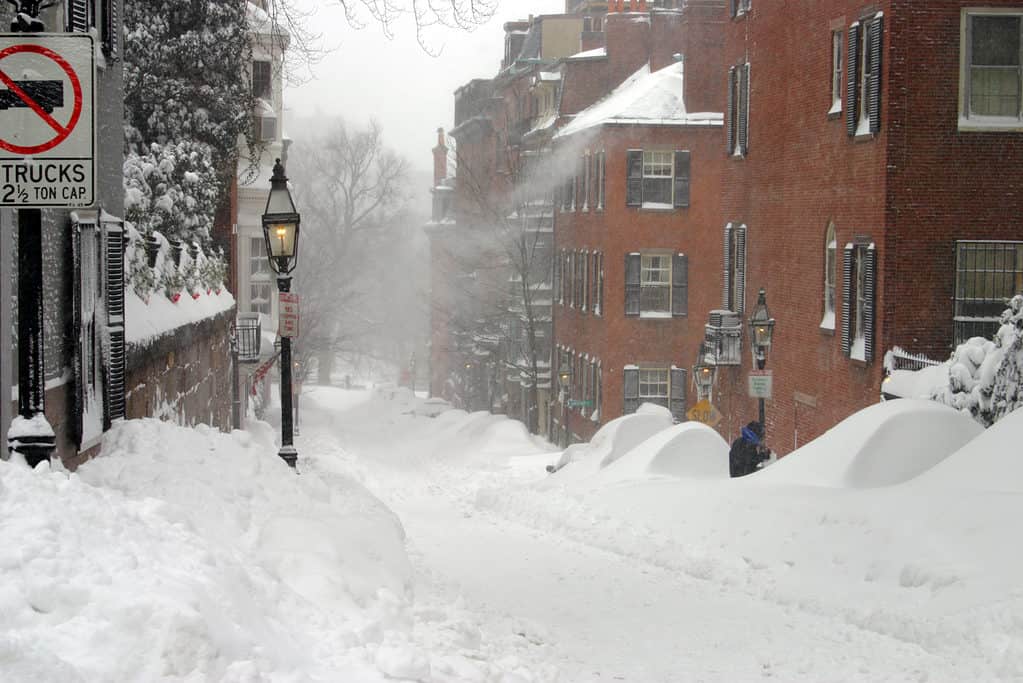Massachusetts is in New England, a region in the Northeastern United States known for its harsh winters and heavy snowfall. The coldest temperatures and snow typically arrive in Massachusetts in December, the first month of winter. However, in November of 1898, a massive storm took Massachusetts residents by surprise. It set the record in Boston for the most daily snowfall in November, and this record has remained ever since. The storm destroyed houses, sank ships, and produced hurricane-force winds that downed trees and telegraph wire poles. This article explores the biggest snowstorm to ever hit Massachusetts in November.
The Great Blizzard of November 1898
The Portland Gale of 1898 was the largest snowstorm to ever hit Massachusetts in November. On the afternoon of Saturday, November 26, 1898, the Portland Gale first hit Massachusetts. The storm was relatively mild on Saturday, but in the early morning hours of Sunday, November 27, it developed into a massive blizzard. Snowfall in Fall River, a town in Southeastern Massachusetts, reached 16 inches. Additionally, wind speeds up to 60 miles per hour were recorded. According to the Fall River Daily Evening News, a newspaper that ran from 1870 to 1926, the coldest temperature recorded in Fall River during the storm was 25 °F. Boston’s record for daily snowfall in November was set at 12 inches on November 27 and has remained the record since.

The snowiest month in Boston is February, with an average of 14.4 inches.
©CO Leong/Shutterstock.com
This devastating storm was later named the Portland Gale after the SS Portland, a steamship carrying 192 passengers and crew members that was tragically lost to the storm. The SS Portland was headed from Boston to Portland, Maine. Today, the site of the shipwreck and its remains is on the United States National Register of Historic Places.
The SS Portland was a great loss, but it was not the only ship to sink during the Portland Gale. Several more ships sank, houses were destroyed, and telegraph wires were downed. Let’s explore more of the devastating impacts of the Portland Gale in Massachusetts.
Impacts of the Portland Gale in Massachusetts
The Portland Gale downed trees and telegraph wires all across eastern Massachusetts. This caused a massive disruption to carriage traffic and communication. The town of Fall River was cut off from any sort of communication from around 2:00 AM Sunday morning until 3:00 PM Sunday afternoon. Many of the trees and wires went down early Sunday morning when the greatest wind velocity was recorded. In addition to the downed trees and wires, a railroad bridge was also destroyed in Tiverton, Rhode Island, which borders Fall River to the south.

Train service from Fall River, Massachusetts to Rhode Island was disrupted after the Portland Gale.
©NayaDadara/Shutterstock.com
The coast of Massachusetts also saw heavy impacts from the Portland Gale. Cohasset Harbor saw a storm surge of around 10 feet. Over 150 boats, including the SS Portland, sank off the Massachusetts coast. The storm took over 400 lives, making it the deadliest natural disaster in Massachusetts’ history until the Great New England Hurricane of 1938.
Finally, the Portland Gale changed the course of the North River, a 12-mile-long tidal river that flows into Massachusetts Bay.
Massachusetts’ Wildlife During the Storm
Animals that live in the temperate New England climate are generally well-adapted to cold and snowy conditions.
Birds have several strategies to stay warm including shivering, fluffing their feathers, roosting, and huddling together.
Waterfowl will also tuck their long legs and necks into their body to keep warm.
As for mammals, they typically take up shelter in dens and become dormant during the winter. One kind of dormancy is true hibernation, which bears, squirrels, and bats do.

Eastern gray squirrels do not hibernate, but they retreat to their nests during winter cold waves.
©iStock.com/Dgwildlife
Reptiles and amphibians also become dormant, which is called brumation. It is similar to hibernation.
Finally, let’s see how the Portland Gale of November 1898 compares to the worst snowstorm to ever hit Massachusetts, in any month.
The Worst Blizzard to Ever Hit Massachusetts
The worst blizzard to hit Massachusetts was the Northeastern United States blizzard of February 1978. The storm broke the record for daily snowfall in Boston at 27.1 inches. This snow fell on top of the nearly 2 feet of snow that was already on the ground when the storm hit. In addition to the massive snowfall, the blizzard also brought hurricane-force winds with gusts over 100 miles per hour, which downed many trees and power lines. Car traffic was banned in eastern Massachusetts for a week after many people had become stranded in their cars on the first day of the storm.
Thank you for reading! Have some feedback for us? Contact the AZ Animals editorial team.








